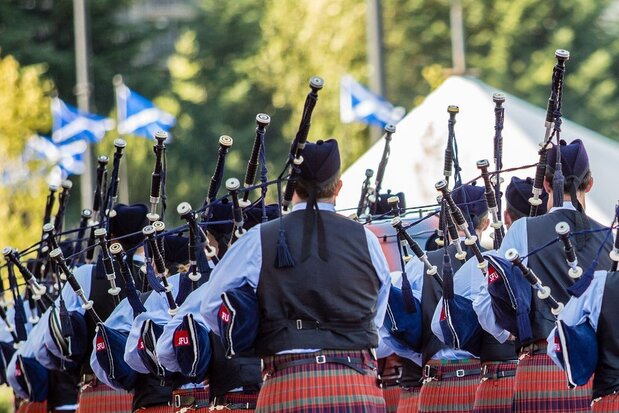You may love the music of bagpipes or you may not quite like them, but you certainly cannot ignore the sound when you hear the lilting tunes. Back in the day, Aristophanes, a comic playwright of ancient Athens, joked about pipers from Thebes equating the sound with wailing dogs. That never dimmed its popularity throughout England. Both Henry VII and Henry VIII are said to have enjoyed the music of the pipers. From Chaucer to Shakespeare, the bagpipe has been mentioned by many. It travelled from country to country, revered to this day, making its own name in the pages of history.
The origin of the bagpipe is rather interesting. Contrary to popular belief, it was not born in Scotland but has its origins in the Middle East after which it travelled all the way to Europe and made its presence there. Here are a few fun facts to see the instrument in a new light.
10 Fun Facts
- The Gaelic word for “bagpipe” is “P’iob mho’r” that literally means “big pipe.”
- The classical bagpipe music has an equally tongue-twisting name: “piobaireachd” (pronounced “peebrock”).
- The bagpipe was traditionally made from the skin of sheep or elk skin which is turned inside out. Pipes were attached to the pockets where the legs and neck once were. Thankfully, modern bagpipes are made of artificial fabric such as Goretex.
- The first documented European bagpipe dates back to 1,000 BC. References to the bagpipes in written form dates back to the 2nd century AD.
- They were used in Great Britain, Ireland, Spain, Italy, France, Greece and Bulgaria. The Roman bagpipes were called “tibia utricularis” and the Bulgarian was called “Gaida.” Even the Tunisians, Egyptians and Indians developed bagpipe-like instruments. The Zampongno that evolved in Italy is fitted with two chanters.
- The Scottish Highland bagpipes were used as an instrument of war right from the 16th century.
- The chanter doesn’t rest between the tunes. The volume of the tune cannot be changed. The variation in tones is created through three drones that are belted out the top of the bag that produces a constant sound.
- The Highland pipes are just one among thirty different varieties of bagpipes that have evolved worldwide. Unlike most other cultures, they kept the tradition of the bagpipe music alive. Don’t be surprised to find a great grand uncle or two in Scottish families who played the “Gaita.”
- The instrument is comprised of several parts such as the blowpipe, the bag, the chanter reed, and the drone or drones. The chanter is from where the melody is created by the piper. The drone or drones belts out the constant note that doesn’t carry any variation.
- There are nine notes that can be played through the bagpipe, ranging from G to A. The bagpipe bags hold air. The piper blows into it through a tube or pumps it with bellows. The air is pushed out creating a wailing sound when the bag is pressed or squeezed, called “drone.” Each drone plays a different but constant note with no variation through a vibrating single or double reed. The harmony is created by the “chanter.”
TartanTown - Your Scottish Department Store for Over 40 Years
We offer all things Scottish from traditional highland bagpipers to the tartan kilt, dance shoes and more for weddings, special events, graduations, birthdays and exclusive occasions. Our accessories are of the highest quality, available both for purchase and rent.
We now offer Lee and Sons African blackwood bagpipes that are handmade in Canada. Give us a call to entice your guests with the vibrant and rich sound.









